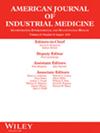Occupational Exposure Patterns to Disinfectants and Cleaning Products and Its Association With Asthma Among French Healthcare Workers
Abstract
Background
Disinfectants and cleaning products (DCPs) are important asthma risk factors among healthcare workers. However, healthcare work involves heterogenous cleaning tasks and co-exposure to many chemicals. These multidimensional aspects have rarely been considered. We aimed to identify patterns of occupational exposure to DCPs and study their associations with asthma.
Methods
CONSTANCES is a French population-based cohort of ≈220,000 adults. Current asthma and asthma symptom score were defined by questionnaire at inclusion (2012–2021). Healthcare workers completed a supplementary questionnaire on their current/last held occupation, workplace, and cleaning activities that were used in unsupervised learning algorithms to identify occupational exposure patterns. Logistic and negative binomial regression models, adjusted for potential confounders, were used to assess associations with asthma outcomes.
Results
In 5512 healthcare workers, four occupational exposure clusters were identified: Cluster1 (C1, 42%, reference), mainly characterized by low exposed nurses and physicians; C2 (7%), medical laboratory staff moderately exposed to common DCPs (chlorine/bleach, alcohol); C3 (41%), nursing assistants and nurses highly exposed to a few DCPs (mainly quaternary ammonium compounds); and C4 (10%), nurses and nursing assistants highly exposed to multiple DCPs (e.g., glutaraldehyde, hydrogen peroxide, and acids). Among women (n = 3734), C2 (mean score ratio [95% CI]: 1.31 [1.02; 1.68]) and C3 (1.18 [1.03; 1.36]) were associated with higher asthma symptom score, and an association was suggested between C3 and current asthma (odds ratio 1.22 [0.99; 1.51]).
Conclusion
In a large population of healthcare workers, four DCP exposure patterns were identified, reflecting the heterogeneity of healthcare jobs. Two patterns, including one characterized by laboratory workers, were associated with greater asthma symptoms in women.


 求助内容:
求助内容: 应助结果提醒方式:
应助结果提醒方式:


